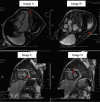Pericardial Mesothelioma Presenting as Constrictive Pericarditis
- PMID: 35602795
- PMCID: PMC9118672
- DOI: 10.7759/cureus.24270
Pericardial Mesothelioma Presenting as Constrictive Pericarditis
Abstract
This case report presents a 60-year-old gentleman with a significant smoking history and possible asbestos exposure who was referred to the emergency department for atrial fibrillation with a rapid ventricular rate and symptoms of heart failure. Labs showed normal brain natriuretic peptide and troponin I. His echocardiography finding suggested constrictive pericarditis with an ejection fraction of 60%. A computed tomography scan was concerning for a pericardial mass. Left and right heart catheterization hinted more toward constrictive physiology; however, some findings were concerning for restrictive physiology. Hence, cardiac magnetic resonance imaging was done, which established the diagnosis of constrictive pericarditis. Pericardiectomy was planned with a maze procedure for atrial fibrillation. However, a malignant neoplasm was seen on a frozen biopsy. Hence, surgery was limited to partial pericardiectomy, as the patient had advanced infiltrative neoplasm that had resulted in constrictive pericarditis. The final pathology report confirmed the diagnosis of malignant pericardial mesothelioma mixed type. Malignancy is usually diagnosed in an advanced stage, like in our case, due to nonspecific initial presentation. A literature review suggests that there is a lack of established consensus on treatment. The response to therapy also seems to be poor and results only in palliation of symptoms, with a median survival of six months from diagnosis despite optimum medical management.
Keywords: constrictive pericarditis; constrictive physiology; pericardial mass; pericardial mesothelioma; pericardiectomy.
Copyright © 2022, Shrestha et al.
Conflict of interest statement
The authors have declared that no competing interests exist.
Figures





References
-
- Malignant mesothelioma 1982: review of 4710 published cases. Hillerdal G. https://pubmed.ncbi.nlm.nih.gov/6357260/ Br J Dis Chest. 1983;77:321–343. - PubMed
-
- Neoplastic pericarditis. Cohen JL. https://www.unboundmedicine.com/medline/citation/1000541/Neoplastic_peri.... Cardiovasc Clin. 1976;7:257–269. - PubMed
-
- Pericardial malignant mesothelioma: a latent complication of radiotherapy? Small GR, Nicolson M, Buchan K, Broadhurst P. Eur J Cardiothorac Surg. 2008;33:745–747. - PubMed
Publication types
LinkOut - more resources
Full Text Sources
